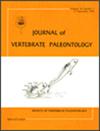The first articulated skull roof and braincase of Melvius chauliodous (Amiidae, Vidalamiinae) from the Upper Cretaceous Kirtland Formation, San Juan Basin, New MexicoCitation for this article: Sullivan, R. M., Jasinski, S. E., & Williamson, T. E. (2023) The first articulated skull roof and braincase of Melvius chauliodous (Amiidae, Vidalamiinae) from the Upper Cretaceous Kirtland Formation, San Juan Basin, New Mexico. Journal of Vertebrate Paleontology . https://doi.org…
IF 1.9
4区 地球科学
Q2 PALEONTOLOGY
引用次数: 0
Abstract
ABSTRACTA new, exceptionally well-preserved articulated skull roof and braincase of Melvius chauliodous, from the Kirtland Formation of New Mexico, reveals new features that provide detailed osteological information for Melvius, thus allowing for a reassessment of characters that defines the genus, its two recognized species M. chauliodous and M. thomasi, and its phylogenetic relationships within Vidalamiinae. The new features include the presence of dermopterotic rays (‘ribs’) and parietal ray bundles, previously unknown for both species of Melvius. The presence of elongated dermopterotic rays, a feature previously considered to be distinctive for the genus Calamopleurus, and tribe Calamopleurini, is now documented in Melvius, but these rays differ in their point of origination at the posteromedial corners of both dermopterotics. Bundles of short fan-shaped rays emanating from below the posterolateral corners of the parietals are also documented in both species of Melvius. Melvius was previously placed in the tribe Vidalamiini (Subfamily Vidalamiinae), but because it shares some unique features with members of the tribe Calamopleurini and the genus Calamopleurus, its placement within Vidalamiini, and the recognition of these two distinct clades (tribes) within Vidalamiinae, are not supported in our phylogenetic analysis. Previous characters distinguishing Melvius species, particularly differences in postinfraorbital ornamentation between M. chauliodous and M. thomasi, are considered dubious. However, other features may serve to determine interspecific variation or differences. For the present, we retain both species until more definitive material of M. thomasi is described. ACKNOWLEDGMENTSForemost, RMS thanks J. Petersen (discoverer) and T. Knopick who helped collect the specimen, and who have been invaluable field assistants to RMS in collecting fossil vertebrates from the San Juan Basin for over a decade. We are especially grateful to P. Holroyd (UCMP) for providing photos of UCMP 131707 and UCMP 129681 that were crucial in identifying this latter element. Thanks are also extended to M. Sims (KU Biodiversity Institute and Natural History Museum) for verifying the locality information of the KUVP specimens mentioned within and for providing us with high resolution photos of KUVP 88378 that helped in interpreting and reconfirming the identity of this element. Special thanks to T. Tokaryk and M. Gilbert for additional information regarding Canadian occurrences of Melvius. RMS thanks D. Fowler (Dickinson Museum Center and Badlands Dinosaur Museum) for discussions regarding phylogenetic analyses and paleogeography as they pertain to this study. N. Volden (NMMNH) aided in securing information regarding the fossil amiid specimens previously housed in the collections of the University of New Mexico and we thank her for her help. L. Rinehart prepared the ventral side of NMMNH P-88899 and RMS prepared the dorsal side of the specimen. RMS thanks P. Reser for making recommendations regarding the preparation of the dorsal side of the skull which is greatly appreciated. We are most grateful to L. Cavin (Muséum d’histoire Naturelle, Geneva) for his insightful comments and additional correspondence regarding fossil amiid fishes and for reviewing our paper. We also thank P. L. Godoy and an anonymous reviewer who greatly improved an earlier version of this manuscript. We thank JVP editors T. Argyriou and J. Harris for their guidance in the publication of our manuscript. Lastly, we thank P. Gensler Bureau of Land Management (BLM) for his continued support in our research in the San Juan Basin of New Mexico and for issuing the necessary permits needed to conduct our fieldwork. Both newly referred specimens (NMMNH P-88899 and P-88901) were collected under BLM Paleontological Resources Use Permit No. NM 14-09S (renewal) issued to S. Lucas, T. Williamson, and G. Morgan.AUTHOR CONTRIBUTIONSRMS and SEJ conceived and executed the project, drafted the manuscript, scored the characters, and edited the manuscript. SEJ ran the analyses. RMS, SEJ and TEW analyzed the data and reviewed this version.SUPPLEMENTARY FILESSupplementary Data 1: document including Figs. S1, S2, Tables S1–S4, Character list, Data matrix, Discussion of Grande and Bemis (Citation1998) phylogenetic results, and supplemental references.Supplementary Data 2: NEXUS file.Supplementary Data 3: TNT file.Supplementary Data 4: Most parsimonious trees file.新墨西哥州圣胡安盆地上白垩统Kirtland组首次发现的Melvius chauliodous (Amiidae, vidalamiae)的关节头盖骨顶和脑壳。Williamson, t.e.(2023)新墨西哥州圣胡安盆地上白垩统Kirtland组首次发现的Melvius chauliodous (Amiidae, Vidalamiinae)的关节头盖骨顶和脑壳。古脊椎动物杂志。https://doi.org..。
来自美国新墨西哥州Kirtland地层的Melvius chauliodous新发现的保存异常完好的关节头盖和脑壳揭示了Melvius的新特征,为Melvius提供了详细的骨学信息,从而允许重新评估定义该属的特征,其两个公认的物种M. chauliodous和M. thomasi,以及其在Vidalamiinae中的系统发育关系。新的特征包括皮肤变异射线(“肋骨”)和顶骨射线束的存在,这两种梅尔维乌斯以前都不知道。细长的皮肤变形射线的存在,以前被认为是Calamopleurus属和Calamopleurini部落的特征,现在在Melvius中有记录,但这些射线在两种皮肤变形的后内侧角的起源点不同。在这两种麦尔维斯鱼的顶骨后外侧角下方也有记录显示出短的扇形射线束。Melvius先前被置于Vidalamiini部落(vidalamiae亚科),但由于它与Calamopleurini部落和Calamopleurus属成员具有一些独特的特征,因此它在Vidalamiini中的位置以及在Vidalamiinae中这两个不同的分支(部落)的识别在我们的系统发育分析中没有得到支持。以前区分梅尔维乌斯种的特征,特别是M. chauliodous和M. thomasi在眶后装饰上的差异,被认为是可疑的。然而,其他特征可能决定种间变异或差异。目前,我们保留这两个物种,直到更明确的材料的M. thomasi描述。首先,RMS感谢J. Petersen(发现者)和T. Knopick,他们帮助收集了标本,十多年来,他们一直是RMS在圣胡安盆地收集脊椎动物化石的宝贵现场助手。我们特别感谢P. Holroyd (UCMP)提供UCMP 131707和UCMP 129681的照片,这些照片对识别后一个元素至关重要。同时也要感谢M. Sims (KU生物多样性研究所和自然历史博物馆),他为我们提供了KUVP 88378的高分辨率照片,帮助我们解释和再次确认该元素的身份。特别感谢T. Tokaryk和M. Gilbert提供关于加拿大梅尔维厄斯发生情况的更多资料。RMS感谢D. Fowler (Dickinson博物馆中心和Badlands恐龙博物馆)对系统发育分析和古地理的讨论,因为它们与这项研究有关。N. Volden (NMMNH)协助获得了有关以前存放在新墨西哥大学收藏的化石标本的信息,我们感谢她的帮助。L. Rinehart制备NMMNH P-88899的腹侧,RMS制备标本的背侧。RMS感谢P. Reser提出的关于颅骨背侧准备的建议,这是非常赞赏的。我们非常感谢L. Cavin (musum d’histoire Naturelle, Geneva)对鱼类化石的深刻评论和补充信件以及对我们论文的审阅。我们还要感谢p.l. Godoy和一位匿名审稿人,他极大地改进了本文的早期版本。我们感谢JVP编辑T. Argyriou和J. Harris在我们的手稿出版过程中的指导。最后,我们感谢P. Gensler土地管理局(BLM)继续支持我们在新墨西哥州圣胡安盆地的研究,并为我们的实地工作发放了必要的许可证。两份新纳入的标本(NMMNH P-88899和P-88901)均在BLM古生物资源使用许可证号下采集。NM 14-09S(续期)发给S. Lucas, T. Williamson和G. Morgan。srms和SEJ构思并执行了该项目,起草了手稿,为人物评分,并编辑了手稿。SEJ进行了分析。RMS, SEJ和TEW对数据进行了分析,并对该版本进行了评审。补充资料1:包含图的文件。S1, S2,表S1 - s4,特征列表,数据矩阵,讨论Grande和Bemis (Citation1998)系统发育结果,和补充参考文献。补充数据2:NEXUS文件。补充数据3:TNT文件。补充数据4:最节俭的树文件。
本文章由计算机程序翻译,如有差异,请以英文原文为准。
求助全文
约1分钟内获得全文
求助全文
来源期刊
CiteScore
2.90
自引率
7.10%
发文量
58
审稿时长
4-8 weeks
期刊介绍:
The Journal of Vertebrate Paleontology publishes original contributions on all aspects of vertebrate paleobiology, including vertebrate origins, evolution, functional morphology, taxonomy, biostratigraphy, phylogenetics, paleoecology, paleobiogeography, and paleoanthropology. JVP publishes high quality peer-reviewed original articles, occasional reviews, and interdisciplinary papers. It is international in scope, and emphasizes both specimen- and field-based based research and the use of high-quality illustrations. Priority is given to articles dealing with topics of broad interest to the entire vertebrate paleontology community and to high-impact specialist studies. Articles dealing with narrower topics, including notes on taxonomic name changes (unless these deal with errors published in JVP), preliminary site reports, and documentation of new specimens of well-known taxa, are afforded lower priority.

 求助内容:
求助内容: 应助结果提醒方式:
应助结果提醒方式:


